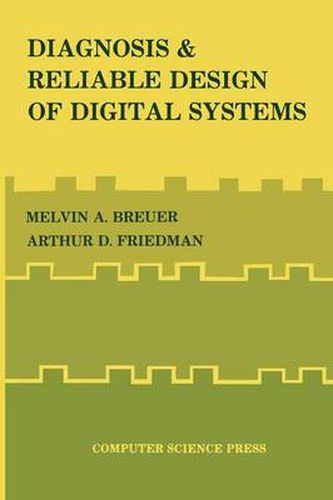Readings Newsletter
Become a Readings Member to make your shopping experience even easier.
Sign in or sign up for free!
You’re not far away from qualifying for FREE standard shipping within Australia
You’ve qualified for FREE standard shipping within Australia
The cart is loading…






This title is printed to order. This book may have been self-published. If so, we cannot guarantee the quality of the content. In the main most books will have gone through the editing process however some may not. We therefore suggest that you be aware of this before ordering this book. If in doubt check either the author or publisher’s details as we are unable to accept any returns unless they are faulty. Please contact us if you have any questions.
Since the early 1960’s there has developed a great interest, both in industry and academia, in the subjects of maintenance and reliability of digital systems. The increased complexity of current systems makes this interest well justified. Costs associated with the necessity to maintain such systems represent a substantial and growing percentage of total system costs. In this book we consider many of the problems associated with diagnosing failures in digital systems, locating the source of such failures, and the related problem of design of ultra reliable systems - systems which do not fail despite the presence of physical defects (fault tolerance), systems which diagnose their own failures (self checking), and systems which are easily tested. Although many of the problems considered are in theory intractable, in practice most have solution procedures which are practical and effective. The book emphasizes these procedures and when available presents several procedures for each problem. With the increased interest in this subject area courses have been devel oped at many universities. This book is intended as a text for such courses and can also be used for self study by the practicing engineer familiar with digital circuits and systems. The first chapter is an introduction to the subject matter and notation of the book. The next two chapters consider in detail the problems associated with efficient detection and location of fail ures in combinational and sequential circuits respectively.
$9.00 standard shipping within Australia
FREE standard shipping within Australia for orders over $100.00
Express & International shipping calculated at checkout
This title is printed to order. This book may have been self-published. If so, we cannot guarantee the quality of the content. In the main most books will have gone through the editing process however some may not. We therefore suggest that you be aware of this before ordering this book. If in doubt check either the author or publisher’s details as we are unable to accept any returns unless they are faulty. Please contact us if you have any questions.
Since the early 1960’s there has developed a great interest, both in industry and academia, in the subjects of maintenance and reliability of digital systems. The increased complexity of current systems makes this interest well justified. Costs associated with the necessity to maintain such systems represent a substantial and growing percentage of total system costs. In this book we consider many of the problems associated with diagnosing failures in digital systems, locating the source of such failures, and the related problem of design of ultra reliable systems - systems which do not fail despite the presence of physical defects (fault tolerance), systems which diagnose their own failures (self checking), and systems which are easily tested. Although many of the problems considered are in theory intractable, in practice most have solution procedures which are practical and effective. The book emphasizes these procedures and when available presents several procedures for each problem. With the increased interest in this subject area courses have been devel oped at many universities. This book is intended as a text for such courses and can also be used for self study by the practicing engineer familiar with digital circuits and systems. The first chapter is an introduction to the subject matter and notation of the book. The next two chapters consider in detail the problems associated with efficient detection and location of fail ures in combinational and sequential circuits respectively.